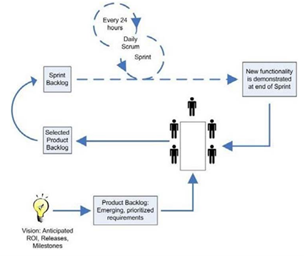Prototype of a Mobile Application for the Detection of Car Accidents on the Roads of Peru
Main Article Content
Abstract
According to studies of the World Health Organization at least around 1. 35 million deaths and between 20 to 50 million injuries are caused due to car accidents, due to this fact the present research work seeks to mitigate this figure before the problem of car accidents on the roads of Lima, that is why a mobile application was designed whose objective is to detect and report accidents, when performing this action the driver sends his contact information (ID, phone, email, family number) and location in real time to the nearby authorities such as police stations or hospitals and likewise the message comes as a notification to their families. For its development we used the agile methodology Scrum whose structure was very useful to display the information proposed, also design tools such as Balsamiq and Marvel App were used to create the interface. Finally, it is concluded that car accidents is a problem that negatively affects our society, also with the application it was possible to design an interactive application that will be very useful for drivers if it is ever implemented, on the other hand, this research seeks to encourage researchers to use technological means to improve the quality of life of people and thus continue to advance as a socie.
Article Details
References
D. Tian, C. Zhang, X. Duan, and X. Wang, “An Automatic Car Accident Detection Method Based on Cooperative Vehicle Infrastructure Systems,” IEEE Access, vol. 7, 2019, doi: 10.1109/ACCESS.2019.2939532.
[M. Tadege, “Determinants of fatal car accident risk in Finote Selam town, Northwest Ethiopia,” BMC Public Health, vol. 20, no. 1, 2020, doi: 10.1186/s12889-020-08760-z.
L. S. R. Pitta et al., “Older drivers are at increased risk of fatal crash involvement: Results of a systematic review and meta-analysis,” Archives of Gerontology and Geriatrics, vol. 95. 2021. doi: 10.1016/j.archger.2021.104414.
P. V. de S. Sassim et al., “PERFIL DOS PACIENTES INTERNADOS POR ACIDENTES AUTOMOBILÍSTICOS NO HOSPITAL METROPOLITANO DE URGÊNCIA E EMERGÊNCIA DE ANANINDEUA NO PERÍODO DE 2006 À 2012,” Centro de Pesquisas Avançadas em Qualidade de Vida, no. v12n3, 2020, doi: 10.36692/v12n3-4.
F. Famoye, “On the Generalized Poisson Regression Model with an Application to Accident Data,” Journal of Data Science, vol. 2, no. 3, 2021, doi: 10.6339/jds.2004.02(3).167.
K. L. S. Soujanya and S. S. Rajasekhar Gutta, “Accident alert system with IoT and mobile application,” International Journal of Recent Technology and Engineering, vol. 7, no. 5, 2019.
E. Çak?r, R. F??k?n, and C. Sevgili, “Investigation of tugboat accidents severity: An application of association rule mining algorithms,” Reliab Eng Syst Saf, vol. 209, 2021, doi: 10.1016/j.ress.2021.107470.
A. Kashevnik, I. Lashkov, and A. Gurtov, “Methodology and Mobile Application for Driver Behavior Analysis and Accident Prevention,” IEEE Transactions on Intelligent Transportation Systems, vol. 21, no. 6, 2020, doi: 10.1109/TITS.2019.2918328.
Prof. A. Gadekar, “SMART APPLICATION FOR POST ACCIDENT MANAGEMENT USING IOT,” International Journal of Advanced Research in Computer Science, vol. 9, no. 2, pp. 684–687, Feb. 2018, doi: 10.26483/ijarcs.v9i2.5718.
O. A. Dada and I. T. Sanusi, “The adoption of Software Engineering practices in a Scrum environment,” African Journal of Science, Technology, Innovation and Development, 2021, doi: 10.1080/20421338.2021.1955431.
A. Hidayati, E. K. Budiardjo, and B. Purwandari, “Scrum Team Competencies in Information Technology Professionals in the Global Software Development Environment,” International Journal of Human Capital and Information Technology Professionals, vol. 13, no. 1, 2022, doi: 10.4018/IJHCITP.293233.
S. A. H. Morales, L. Andrade-Arenas, A. Delgado, and E. L. Huaman?, “Augmented Reality: Prototype for the Teaching-Learning Process in Peru,” International Journal of Advanced Computer Science and Applications, vol. 13, no. 1, 2022, doi: 10.14569/IJACSA.2022.0130194.
A. E. Artyukhov, I. I. Volk, and T. A. Vasylieva, “Agile methodology in higher education quality assurance system for SDGs 4, 8 and 9 achievement: National experience,” in CEUR Workshop Proceedings, 2022, vol. 3085. doi: 10.55056/cte.105.
O. E. Sandoval-Alfaro and R. R. Quintero-Meza, “Application of data analytics techniques for decision making in the retrospective stage of the agile scrum methodology,” 2021. doi: 10.1109/ENC53357.2021.9534800.
M. Martinez and B. Gois Mateus, “Why did developers migrate Android Applications from Java to Kotlin,” IEEE Transactions on Software Engineering, 2021, doi: 10.1109/TSE.2021.3120367.
C. Khawas and P. Shah, “Application of Firebase in Android App Development-A Study,” Int J Comput Appl, vol. 179, no. 46, 2018, doi: 10.5120/ijca2018917200.
L. A. R. Tuanama, J. A. Q. Gutarra, and L. Andrade-Arenas, “Design of a Mobile Application for the Automation of the Census Process in Peru,” International Journal of Advanced Computer Science and Applications, vol. 11, no. 11, 2020, doi: 10.14569/IJACSA.2020.0111184.

